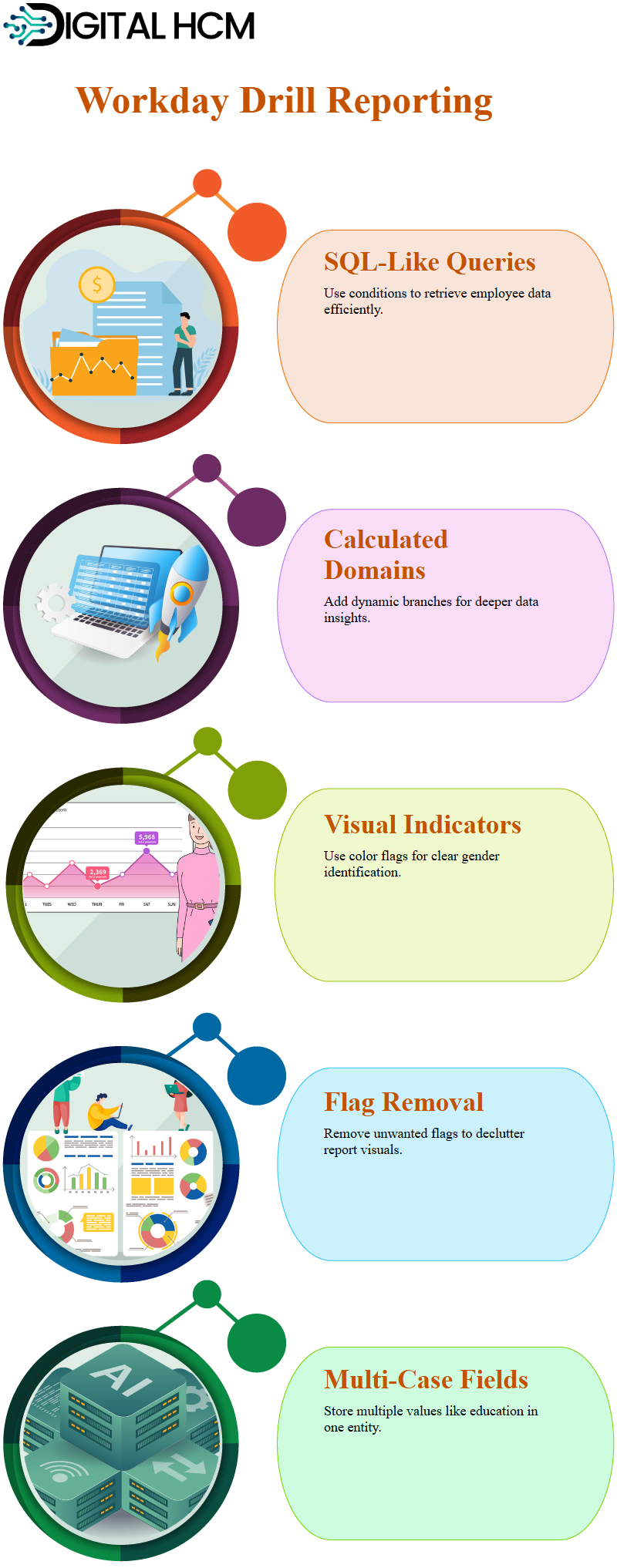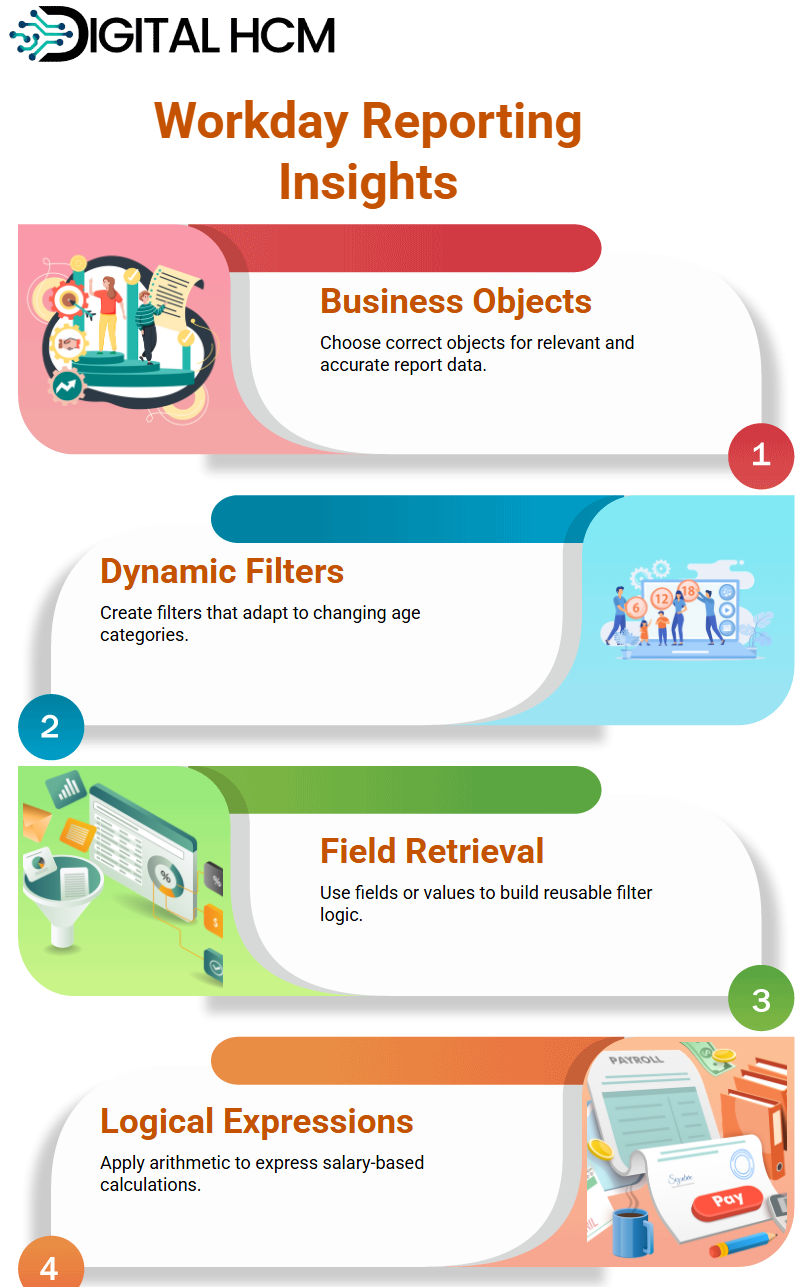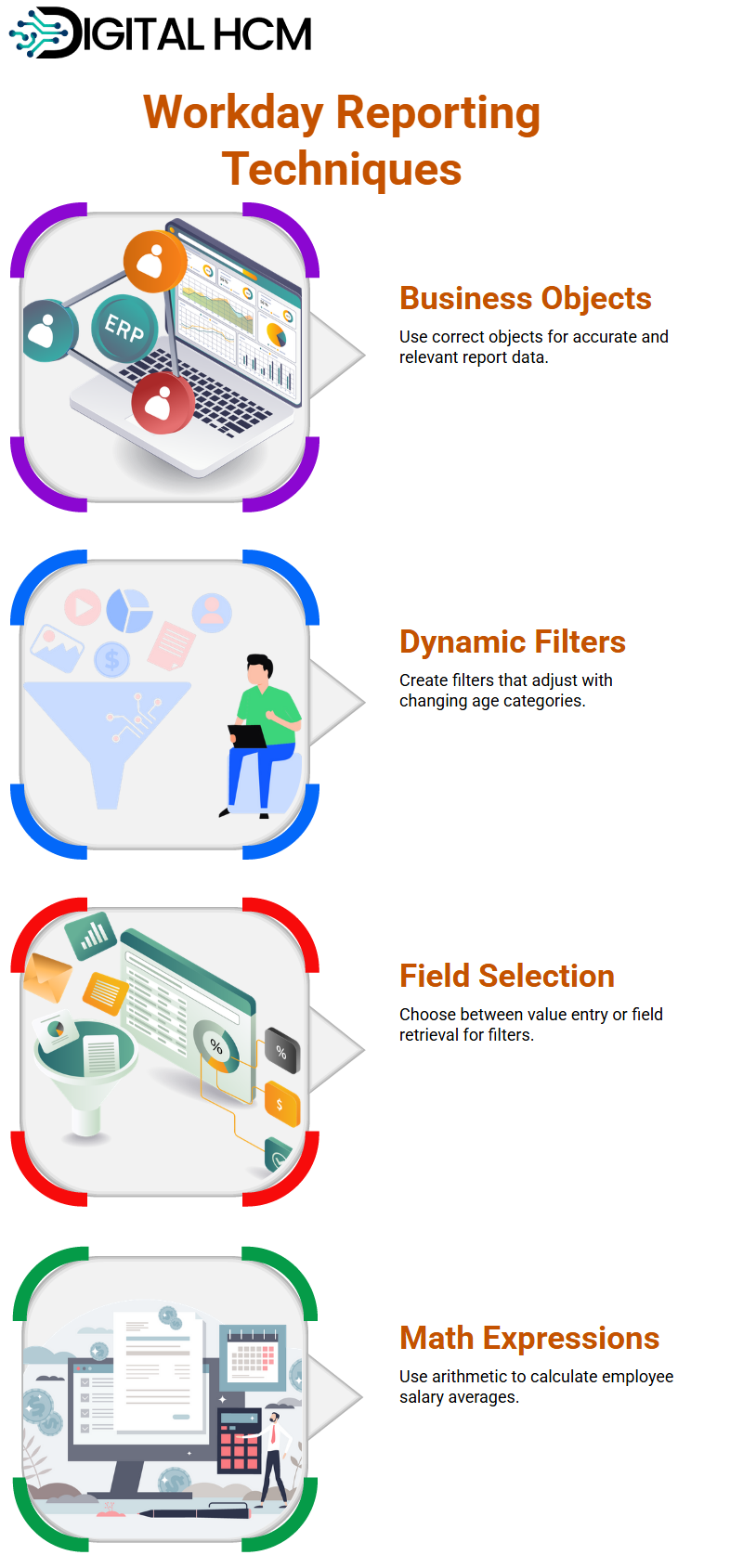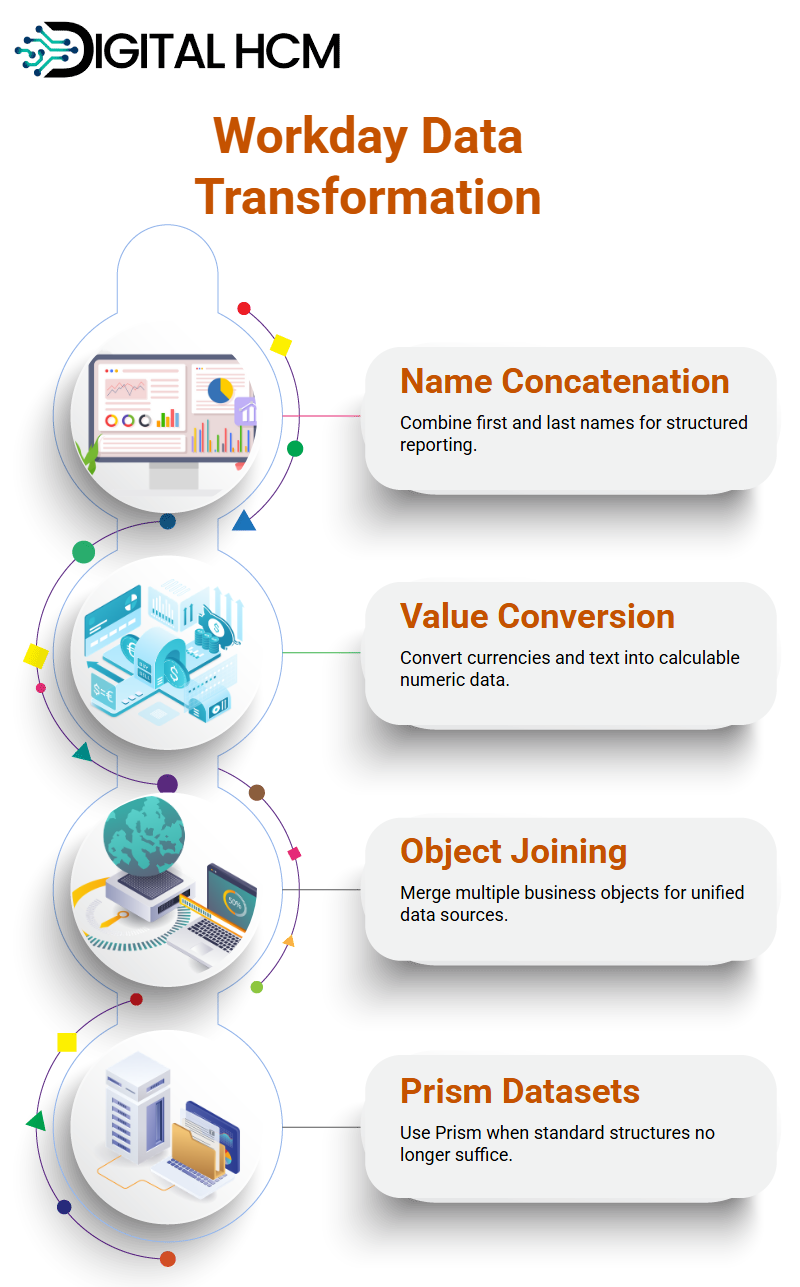Workday Training in New York City, New York, USA
Workday Reporting Course in New York City NY USA.
Recognition of Workday Reporting
Workday Reporting can become ineffective without proper use. With the right knowledge such as that provided by a Workday Reporting course in New York PeopleSoft data managers can easily shift toward producing more valuable reports in Workday Reporting by understanding the details they require for success.
Demonstratively, all relevant staff absence data from PeopleSoft has been saved to Workday Reporting, which serves as a user tool where data is converted into meaningful reports, ready for use.
Workday Reporting enables organisations to consolidate all data in one central location for reporting purposes.
It does not restrict you to using only your internal systems’ information in its reports. In certain circumstances, you may also need to import external systems, such as PeopleSoft, into Workday Reporting for enhanced analysis and insights.
We provide all necessary details, format them correctly, and upload them into Workday Reporting for upload.
To integrate Prism reports and Workday Reporting seamlessly, Comma-Separated Values (CSV) files provide a solution by supporting software to transmit data outward securely.
Conducting Innovative Workday Reporting
Today’s innovative Workday reports are created using data gleaned from various sources, filters, and business objects that enable the creation of scheduled, delightful reports.
The structure of the Problem is crucial, as its solution leads to comprehensive reports that are both conclusive and feasible.
Workday Reporting utilises mandatory domains when necessary to create the desired data format, for example, gender (1).
When changes to male or female occur, a calculated column can be helpful. A Workday Reporting course in New York can help clarify the understanding of these functions.
Workday Reporting as an Asset for Payroll and HR Clarity
Both payroll and HR departments utilise Workday Reporting extensively as specialists have long recognised it as providing fast sequence management with expandable data storage options.
A Workday Reporting course in NY can help teams take full advantage of these capabilities. Workday Reporting can also help preserve institutional memory.
For instance, payroll professionals leaving an organisation can utilise Workday Reporting as a convenient means to document their workflows before departure, thereby maintaining the organisation’s knowledge base.

Workday Reporting's Importance for Employer Data
Business objects play a crucial role in Workday Reporting when including calculated domains in reports.
To do this efficiently, we must select an appropriate business object when prototyping employee data in reports using Workday Reporting.
Workers’ business objects should be leveraged whenever possible to improve efficiency in Workday Reporting.
If you want to learn how to align business objects correctly, a Workday Reporting course in New York can assist.
Without this alignment, business objects in reports won’t match calculations properly, and data related to important features won’t appear in concerns or reports.
Workday Reporting
While Workday Reporting can serve as an analytical and interpretive instrument, in most reports, more variables than usual tend to be added at report time based on specific circumstances; so, while the illustration remains the same, the application style may change with each situation.
Workday Reporting utilises condition statements as one of its foundational concepts, with these expressions reflecting a statement’s true or false state, depending on whether the expression results in the expected values or not.
Now, let’s examine how the Workday Reporting course in New York functions in practice, specifically in the context of gender-based reporting.
Our goal is to obtain results based on employee gender; for example, if male employees were selected, the machine would display “M” by default, and vice versa.
To do this, go to the Gender Field and enter comparable values related to both male and female employees in our search criteria.
Workday Reporting's Solo Case and Multi-Demonstration Sectors
A one-to-one relationship in Workday Reporting can only exist between an employee and a single gender. At the same time, multi-case fields allow for multiple records from different universities that an employee may possess as evidence in their employment application.
Workday provides selection lists as an invaluable way of organising reports. At the same time, Vietnamese individuals can use classes from either of the two universities they graduated from to register, provided they are enrolled in any university in Vietnam.
As consumers, we can select a gender by taking advantage of predetermined values, such as Male or Female, as well as creating customer-specific ones that must match the default ones to maintain consistency and ensure reliability.

How to Utilise Workday Reporting in Drill?
Workday Reporting generates inquiries comparable to SQL commands in terms of the number of inquiries; by selecting employee IDs based on specific conditions, data retrieval becomes significantly smoother.
We can use expressions such as “Equal To” and “Contents Filters” to filter our results efficiently.
Working with calculated domains in Workday Reporting is quite engaging, as you can quickly generate conditions that adapt as the data changes, adding calculated branches to reports or terrains to gain further insights into data analysis.
Workday Reporting Indicators
With Workday Reporting’s indicators-based analytics capabilities, we can add powerful visuals.
For instance, gender marking using colour-coded flags makes gender identification straightforward: blue indicates male, purple indicates female, and red indicates non-declared statuses, which are easily discerned from each other.
To narrow our reports further, Workday Reporting allows us to change analytical indicators. Information must be presented without clutter.
If an undesirable flag appears, its removal can clean it up nicely, allowing users to carry out steps and output without difficulty or hurdles.
Support Multi-Case Categories in Workday Reporting
Let me now turn my focus to multi-case specialities within the Workday Reporting course in New York. As you assemble reports, it may become apparent that different sectors, such as education, behave in unexpected ways.
Workday does not use calculated fields; instead, its multi-illustration field stores multiple values for one entity simultaneously.
Definition of this means selecting education within its respective field will display all pertinent educational details.
Linking educational data to related business objects adds further insight. Differentiating between these is key for creating high-quality Workday Reporting outputs.

Employing Business Objects for Increased Realisations in Workday Reporting
With Workday Reporting’s ability to gather data from multiple business objects quickly and easily, businesses that rely heavily on calculated sectors can leverage these sectors for enhanced insights and stronger outcomes.
Imagine seeking details regarding an employee’s degree year received through an education business object instead of a company business object; this requires being familiar with Workday’s data structure.
Selecting appropriate business objects ensures that reports contain data that is both correct and relevant.
Recognising this distinction helps prevent confusion and enables one to leverage Workday Reporting effectively.
Attending a Workday Reporting lesson in New York can provide you with valuable hands-on experience and practical understanding.
Conceivability Filtering in Workday Reporting:
Filtering is an integral component of Workday Reporting that requires both accuracy and meticulous attention to detail.
In terms of age-based categories, creating filters that adapt to the current time is also vitally important.
An age bracket might evolve for instance, 20-30 may no longer qualify as “beginners,” making an on-menu calculated field that updates with new factors necessary.
A Workday Reporting course in NY can provide practical guidance on building such dynamic filters.
Workday Reporting offers two approaches for creating filters: writing in values or retrieving them from another field. Selecting a practical approach ensures consistent and reusable reporting.
Arithmetic Calculations for Logical Expressions in Workday Reporting
Arithmetic calculations enable us to express mathematical expressions as logical statements using numerical data stored within Workday Reporting.
For instance, when working out employee average salaries using these functions, such as addition, subtraction, multiplication, and division, it would help formulate meaningful expressions for these calculations.
By following the correct order of operations, one can ensure the best possible result. Simply put, this means multiplication comes first before addition for representation purposes.
Workday Reporting course in the USA provides an exceptional opportunity to tailor all expressions to maximise their utility and yield meaningful outcomes.

Concatenation and Data Metamorphoses in Workday Reporting
Reports produced through Workday utilise the process of concatenation to assemble information sourced from multiple locations for instance, by connecting first name and last name data points.
Furthermore, the Workday Reporting course in USA provides users with options for changing currency values and converting text into numerical values that can be calculated.
Together, these methods enable precise data manipulation within the Workday Reporting program, producing more structured and purposeful reports.
Business Object Joins and Workday Reporting Data Manipulation
It can often be necessary to draw evidence from multiple business objects in Workday reporting.
When constraints prevent data merging from various sources, creating a single, unified data source might be the only viable solution available to us.
Successful Workday Reporting usage requires knowing how to modify datasets for optimal outcomes and reuse stored reports for your projects, which can help create straightforward retrieval processes for intricate datasets.
Working with Workday Reporting enables us to locate the required data quickly; however, sometimes the business objects provided do not suit our needs, at which point creating traditional objects may be the best approach.
To master these skills effectively, enrolling in a Workday Reporting course in USA is highly recommended, as it helps users understand how to work with standard data structures and customise reports when standard business objects fall short.
When specific data must remain within Workday after modification to existing structures may no longer suffice, Prism data sets may provide better solutions than altering an existing one.
Imagine gaining insight into employees’ educational backgrounds. Your information may include details such as the name and year of attendance at each school for each employee, as well as certification numbers.
With this data, you aim to create a comprehensive yet straightforward report using Workday Reporting.
One widely adopted solution for this challenge is Loader, an add-in for Lead that authorises its users to conduct data merge operations.
Now, combining information from different sources into one view will become much simpler.

Workday Reporting with Prism
Prism enables you to surpass any limitations with Workday reporting by not only managing and moving data according to your mandates but also creating tables with optimal formats tailored specifically for reports.
Imagine designing the table format yourself; set its schema settings and ensure your data is organised adequately for reports.
Today, we covered the topic of performing mathematical calculations within Workday Reporting and their application towards custom report tailoring.
From basic formula calculations to more intricate ones created via Workday’s cutting-edge reporting functions, all were discussed.
If that sounds appealing to you, consider setting yourself the following challenge as part of your Workday Reporting course in USA training.
Take any advanced report that has already been generated and add two zones with records that contain statistics.
These new records of data can enhance your understanding of Workday Reporting’s capabilities.
Resources to Assist with Workday Reporting
Are You Struggling with Reporting in Workday? When progress stalls, tapping into the Workday community for assistance can be immensely useful in finding solutions.
From examples and tips on solving common problems to advanced insights that may provide the edge needed to identify potential causes, these people offer invaluable input that could have an immediate and positive effect on how you examine your issues and their solutions.
Remember that Workday Reporting requires experimentation to discover new paths and try different solutions to problems.
Continue to explore by constantly revising and evolving your strategy, testing reports for success as you go, and making necessary corrections along the way.

James

Success in your career comes from curiosity, courage, and consistency. Stay committed, stay curious and never stop learning.
